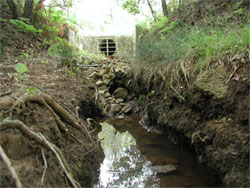Storm Drains
 Storm drains or catch basins are the square metal grates at the sides or curbs of streets. They are designed to collect stormwater to prevent streets and property from flooding. When it begins to rain, the first raindrops soak into the ground.
Storm drains or catch basins are the square metal grates at the sides or curbs of streets. They are designed to collect stormwater to prevent streets and property from flooding. When it begins to rain, the first raindrops soak into the ground.
But once the soil is saturated, or if the soil has been replaced by cement or another impervious barrier, the rain runs along the surface and is caught in storm drains.
Any debris or garbage from driveways, backyards or streets, including products and wastes applied to the ground, can be washed into the storm sewer system.
For many communities, the storm sewer system carries runoff water through pipes to larger pipes or trunk lines buried underground. These pipes then take the water and empty it untreated into the nearest waterway, such as a stream, river or lake.
In some communities, the storm sewer system (stormwater) is combined with the municipal sewer system (wastewater). This is called a combined sewer system. Both water streams are carried through pipes to the wastewater treatment plant.
The water is treated at the plant according to the level of available treatment. However, when there is a large flow of water from a storm, the water at the wastewater treatment plant may be released with minimal treatment. As a result, raw sewage and stormwater enter the waterway.
What Can You Do?
Explore this site to find specific information on the different types of waste and what you can do to to help keep our waterways clean.